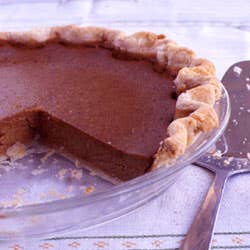
Nothing conveys the holiday spirit as well as pumpkin pie," says SAVEUR consulting editor Marion Cunningham—who is, among other things, editor of the 13th edition of that compendium of American culinary traditions, _The Fanny Farmer Cookbook _(Alfred A. Knopf, 1996), first published in the 40s'. Indeed, the pie's heady perfume, evoking Norman-Rockwellian visions of family-filled homes, has long reigned as the obligatory finish to almost everybody's Thanksgiving dinner. The notion that Indians and Pilgrims shared a piece of pumpkin pie back at the first Thanksgiving, however, is highly doubtful. They ate pumpkin, yes—but most likely it was just baked in its shell.
The first printed pumpkin pie recipe appeared in 1796, in Amelia Simmons's American Cookery, and needless to say, it called for fresh pumpkin. Most pies today, though, start in a can. About 145,000 tons of the squash are annually pureed, processed, and transformed into pies—an estimated 88 million of them in all.
If, as we do, you plan to buck the trend and use fresh pumpkin, Cunningham points out that not every variety will do the job. She says that of the 200 or so eating varieties available, the best pie pumpkin is the sugar baby, which produces a fine, silky puree without a sharp aftertaste. If you're using the real thing, she also recommends a lighter hand with the spices; and with fresh or canned, she adds, don't overbake: "Cook it just until it is set." Pumpkin pie filling is, after all, a custard.
Cunningham admits that she herself often uses canned pumpkin for pies. Nonetheless, as a culinary traditionalist, she thinks pumpkin pie should only be served in the proper season. And it's hard to argue: The pie seems to taste especially good in November.
Keep Reading
Continue to Next Story










